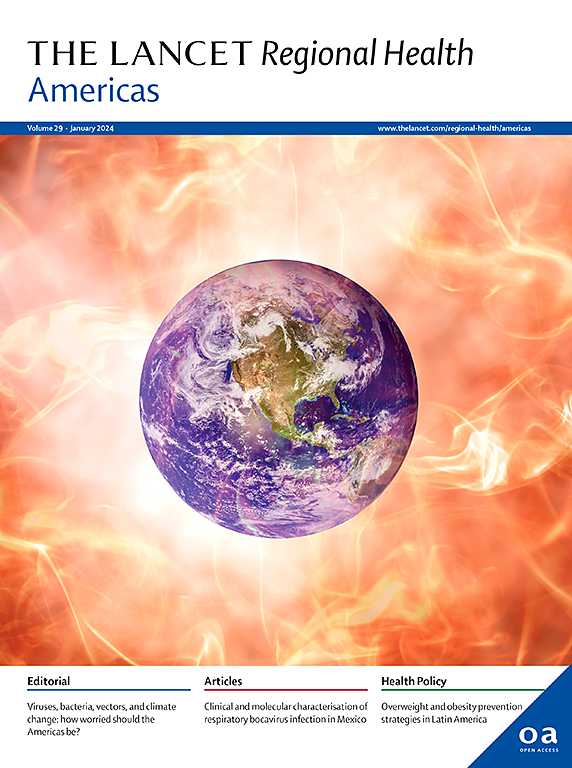在巴西公共卫生系统中,采用STANDARD™G6PD筛查后使用他非诺喹治疗间日疟疾的成本效益
IF 7
Q1 HEALTH CARE SCIENCES & SERVICES
引用次数: 0
摘要
间日疟需要根治来清除血液期和肝脏期寄生虫。与大多数流行国家一样,巴西在没有检测葡萄糖-6-磷酸脱氢酶(G6PD)缺乏症以排除有伯氨喹诱导溶血风险的情况下,一直在为根治提供为期7天的伯氨喹方案。他非诺喹是一种新型单剂量根治药物,在处方前需要进行G6PD筛查,以确保安全性。本研究旨在从巴西公共卫生系统的角度评估半定量G6PD筛查后处方他非诺喹的成本效益。方法对成人12个月间日疟患者建立决策树模型。对G6PD活性≥70%的患者开单剂量他非诺喹处方前进行半定量G6PD检测的他非诺喹策略与:(1)目前的做法:不进行G6PD筛查的7天低剂量伯氨喹(0.5 mg/kg/天)和(2)通过半定量G6PD筛查确定G6PD活性≥30%的患者的7天低剂量伯氨喹(0.5 mg/kg/天)进行比较。主要结果是每个残疾调整生命年(DALY)避免的成本,与巴西的支付意愿阈值7752美元(40,000雷亚尔)相比。结果:与目前的做法相比,他非喹策略每避免的残疾调整年为2894美元(14,934雷亚尔),远低于支付意愿阈值。他非诺喹策略在伯氨喹筛查策略中占主导地位,避免了0.14个DALYs,节省了13美元(66雷亚尔)。在两项比较中,他非诺喹策略具有98%的成本效益可能性。在巴西,对G6PD半定量检测正常的患者开他非诺喹是根治间日疟疾的一种具有成本效益的策略。虽然其他环境中的成本效益可能因成本差异、间日疟疾流行病学和G6PD缺乏症而有所不同,但这些发现的稳健性应该令人放心,特别是在医疗机构预计每年会看到大量患者的情况下。资助疟疾药物项目。本文章由计算机程序翻译,如有差异,请以英文原文为准。
The cost-effectiveness of tafenoquine following screening with STANDARD™ G6PD screening for the treatment of vivax malaria in the Brazilian Public Health System
Background
Vivax malaria requires radical cure to clear both the blood-stage and liver-stage parasites. Brazil, like most endemic countries, has been prescribing a 7-day primaquine regimen for radical cure without testing for glucose-6-phosphate-dehydrogenase (G6PD) deficiency to exclude those at risk of primaquine-induced haemolysis. Tafenoquine, a new single-dose drug for radical cure requires G6PD screening before prescription to ensure safety. This study aims to assess the cost-effectiveness of prescribing tafenoquine after semi-quantitative G6PD screening from the Brazilian Public Health System perspective.
Methods
A decision tree model was developed for adults presenting with vivax malaria over 12-months. The tafenoquine strategy of semi-quantitative G6PD testing before prescription of single-dose tafenoquine to those with ≥70% G6PD activity was compared with: (1) current practice: 7-day low-dose primaquine (0.5 mg/kg/day) without G6PD screening and (2) primaquine screening strategy: 7-day low-dose primaquine (0.5 mg/kg/day) for patients with ≥30% G6PD activity determined by semi-quantitative G6PD screening. The primary outcome was the cost per disability-adjusted life-year (DALY) averted, compared with the Brazilian willingness-to-pay threshold of US$7752 (R$40,000).
Findings
The tafenoquine strategy was US$2894 (R$14,934) per DALY averted compared to current practice, well below the willingness-to-pay threshold. The tafenoquine strategy dominated the primaquine screening strategy, averting 0.14 DALYs with cost savings of US$13 (R$66). In both comparisons, the tafenoquine strategy had a >98% likelihood of being cost-effective.
Interpretation
The prescription of tafenoquine to those who test G6PD normal with a semi-quantitative test is a cost-effective strategy for the radical cure of vivax malaria in Brazil. While the cost-effectiveness in other settings may vary due to differences in costs and the epidemiology of vivax malaria and G6PD deficiency, the robustness of these findings should be reassuring, particularly where healthcare facilities expect to see a large number of patients annually.
Funding
Medicines for Malaria Ventures.
求助全文
通过发布文献求助,成功后即可免费获取论文全文。
去求助
来源期刊

Lancet Regional Health-Americas
Multiple-
CiteScore
8.00
自引率
0.00%
发文量
0
期刊介绍:
The Lancet Regional Health – Americas, an open-access journal, contributes to The Lancet's global initiative by focusing on health-care quality and access in the Americas. It aims to advance clinical practice and health policy in the region, promoting better health outcomes. The journal publishes high-quality original research advocating change or shedding light on clinical practice and health policy. It welcomes submissions on various regional health topics, including infectious diseases, non-communicable diseases, child and adolescent health, maternal and reproductive health, emergency care, health policy, and health equity.
 求助内容:
求助内容: 应助结果提醒方式:
应助结果提醒方式:


